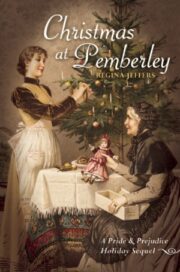English Christmases of the time were entrenched in religious observances. One must remember that in the 16th Century, to prevent subversion, the government banned Christmas celebrations. According to the Jane Austen Centre Magazine, “We have accounts from early 19th Century journals of Christmas days where the writer mentions the holiday but makes absolutely no fuss about it. Likewise, there are records of newspapers, published on December 25th that do not even contain the word Christmas.” (http://www.janeausten.co.uk/magazine/index.ihtml?pid=387&step=4; June 17, 2011).
The gathering of greenery — rosemary, holly, laurel, and mistletoe — to decorate the household appears often in period literature. As for the mistletoe/kissing ball, it became quite elaborate during the Victorian Period. However, many believe the tradition remained below stairs in the servants’ quarters during the Regency Period, but who is to say?
A Yule log to burn throughout the festive days would have been common, as well as the “Christmas candle.” Groups of performers — mummers — date back to the Middle Ages. They sang and performed short plays, and because of their lower class, they often mixed bits of history with the British Napoleonic heroes. Of course, Saint George remained a staple of these plays.
Parlor games entertained houseguests, but there were no caroling or stockings or Christmas trees. Gifts were limited and often took the form of charitable acts by the aristocracy.
With all this in mind, in this story line, I tried to capture the “Christmas story’s lesson,” without all the hoopla of which we nowadays partake. Plus, I took the liberty to add a bit of romance, hope, and intrigue.
In this tale, I have taken some factual liberties in Beauford Manneville’s story. Here are the actual facts of Princess Charlotte’s “indiscretions.” In the spring of 1812, George IV tried to pique his daughter’s interest in William, Prince of Orange — a move which would have strengthened England’s alliance with the Netherlands. William had lived in exile in England and had even been educated in Oxfordshire. At first, Princess Charlotte refused the connection, but the Regent persisted, and at an arranged Carlton House dinner party on December 11, 1813, Charlotte accepted her father’s wishes.
However, the Princess had second thoughts upon discovering that William would expect her to live half of the year in Holland. Part of the problem was that Charlotte feared her mother might follow her to Europe and then Prince George would use his wife’s desertion as grounds for divorce. If so, the Regent would be free to remarry and possibly produce a male heir to the throne. Thus, Charlotte would lose her position as the future queen.
During this time, Mercer Elphinstone was Charlotte’s chief confidante and aided the willful princess with her liaisons.
Charlotte’s next tendre was for Prince Frederick, the King of Prussia’s nephew. In Frederick’s case, Miss Cornelia Knight, one of the princess’s ladies in waiting, arranged several discreet meetings and acts of correspondence. Charlotte’s relationship with Frederick ended in January 1815, when he returned her portrait and informed Charlotte that he had found another.
In July 1814, the Regent became “fed up” with his daughter’s defiance, and he dismissed all her servants and her lady attendants. Charlotte sought protection with her mother Princess Caroline, but still being under the Prince’s domain until age one and twenty, Charlotte was returned to Carlton House.
On Christmas Day 1814, Charlotte sought reconciliation with her father. In doing so, she admitted her recent relationship with Captain Hesse. Princess Caroline had encouraged the connection between her daughter and the captain, and Mercer Elphinstone had arranged the meetings and the correspondence between the lovers.
Charlotte had previously requested a return of her letters from Hesse, who had served as an equerry in Princess Caroline’s service for a time. However, Hesse made no move to respond to Charlotte’s demand, and the foolish princess had anticipated being blackmailed.
Over the next four days, Charlotte ingratiated herself with her father, and the Regent discovered details regarding his wife’s duplicity. During those conversations, Charlotte admitted an interest in Prince Leopold, the third son of the Duke of Saxe-Coburg-Saalfeld, the man whom she would eventually marry.
Those are the facts. This is the fiction: Beauford Manneville was not Captain Hesse’s American relative, and Hesse did not send Princess Charlotte’s letters and personal items to Manneville for safekeeping. Manneville is a plot device and a pure creation of my imagination. He is used to add a “what if ” to the story.
About The Author
Regina Jeffers, an English teacher for thirty-nine years, considers herself a Jane Austen enthusiast. She is the author of several novels, including The Phantom of Pemberley, Darcy’s Passsions, Darcy’s Temptation, Captain Wentworth’s Persuasion, and Vampire Darcy’s Desire. A Time Warner Star Teacher and Martha Holden Jennings Scholar, Jeffers often serves as a consultant in language arts and media literacy. Currently living outside Charlotte, North Carolina, she spends her time with her writing.


"Christmas at Pemberley" отзывы
Отзывы читателей о книге "Christmas at Pemberley". Читайте комментарии и мнения людей о произведении.
Понравилась книга? Поделитесь впечатлениями - оставьте Ваш отзыв и расскажите о книге "Christmas at Pemberley" друзьям в соцсетях.